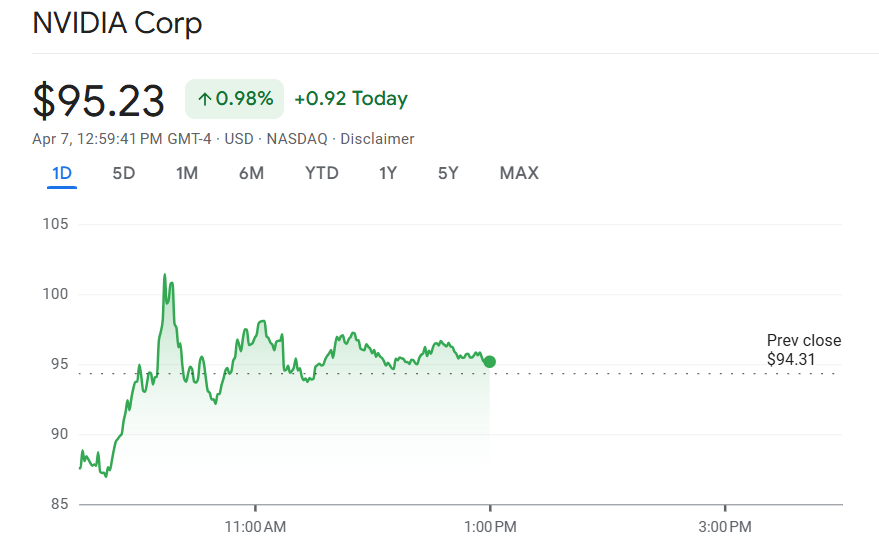Nvidia Corporation (NVDA) has recently found itself at the center of turbulent waves in the stock market, primarily influenced by new tariffs introduced by the U.S. government. As a company widely regarded as a leader in the semiconductor industry and artificial intelligence (AI), the implications of these economic shifts stand to have significant impacts on its stock performance. In this article, we will explore the fallout from tariff announcements, analyze insights from financial analysts, and project future trends for Nvidia’s stock.
The Impact of Tariffs on the Tech Sector
On April 2, 2025, President Donald Trump announced a plan for reciprocal tariffs of at least 10% on various countries, which caused immediate volatility in the stock market. The S&P 500 index plummeted 10% in just two days following the announcement, while the Nasdaq composite experienced an even steeper decline of 11%. These moves indicated significant concerns over the economic implications that tariffs would have on U.S. consumers and industries.
Analysts caution that tariffs could be particularly hard on semiconductor companies, given that they rely on complex supply chains and global manufacturing practices. Bank of America, among other financial institutions, suggested that the tariffs would likely escalate costs for consumers, impacting the demand for tech products, including those from Nvidia.
Nvidia’s Recent Struggles: Pre-Tariff Conditions
Even before the tariffs came into play, Nvidia was facing its own challenges. The company had seen a dramatic 20% decline in its stock during the first quarter of 2025, triggered by various factors including disappointing earnings and the rising competition from cheaper AI models from China, such as DeepSeek.
Analysts noted that Nvidia’s revenue growth, which had previously surged at triple-digit rates, decelerated to 78% year-over-year in Q4 2024. While still impressive, this reduction raised concerns among investors who were looking for higher growth rates.
Analyst Reactions and Future Predictions
In light of the tariff announcements and Nvidia’s previous struggles, a few financial institutions have reassessed their forecasts for the company’s stock. Analysts at HSBC downgraded Nvidia, citing restricted GPU pricing power and ongoing supply chain mismatches.
Bank of America has maintained a more optimistic view, asserting that Nvidia is well-positioned to navigate the complexities introduced by tariffs. Their analysts have projected a recovery in stock performance, especially in the latter half of 2025 as companies adapt to the new economic environment and demand for AI technology continues to grow.
The Bellwether of AI Demand
Nvidia’s standing as a bellwether for AI-driven chip demand remains intact despite the recent volatility. The CEO of Nvidia, Jensen Huang, has touted the extraordinary demand for their new product lines, particularly the Blackwell architecture, which has seen a surge in interest across various sectors, from gaming to machine learning.
The forecast remains cautiously optimistic, particularly as AI technologies increasingly integrate into everyday applications. However, many analysts are wary of the immediate impacts tariffs may have on Nvidia’s profit margins and pricing strategies in the short term.
Understanding the Broader Market Effects
The ramifications of tariffs affect not just Nvidia but the entire tech sector. As products cost more due to tariffs, consumers may limit their spending, which in turn could affect sales for technology companies. This prediction has led to discussions around potential recessions and reduced growth forecasts, as many companies brace for the impact of rising costs.
Moreover, while it is clear that semiconductors are currently excluded from the list of products affected by the tariffs, disruptions in the supply chain can still ripple through the sector. Such uncertainties could dampen production timelines and result in shortages that hinder technological innovation.
Conclusion: What’s Next for Nvidia?
As the landscape continues to evolve post-tariffs, Nvidia’s strategy and adaptability will be pivotal in determining its future trajectory. Investors, consumers, and industry analysts alike will be watching closely as the company recalibrates in the face of new economic challenges.
For those invested in Nvidia, the upcoming quarters could be critical as they seek signs of recovery in stock performance and demand trends amidst an increasingly complicated marketplace. Analysts from various firms remain divided, but the consensus appears to lean toward a cautious positivity, buoyed by Nvidia’s strong fundamentals and ongoing innovations in artificial intelligence.
This period of uncertainty may represent both risk and opportunity for Nvidia, as it navigates external pressures while staying true to its hallmark of innovation. As always, ongoing adjustments in strategy will be vital, and how Nvidia reacts to these challenges will likely define its business landscape for years to come.

